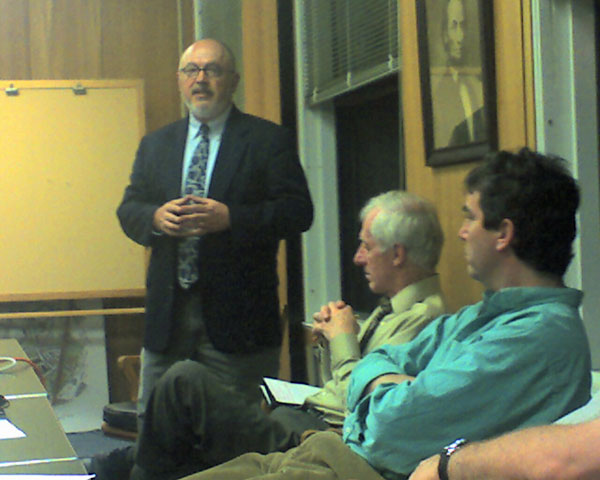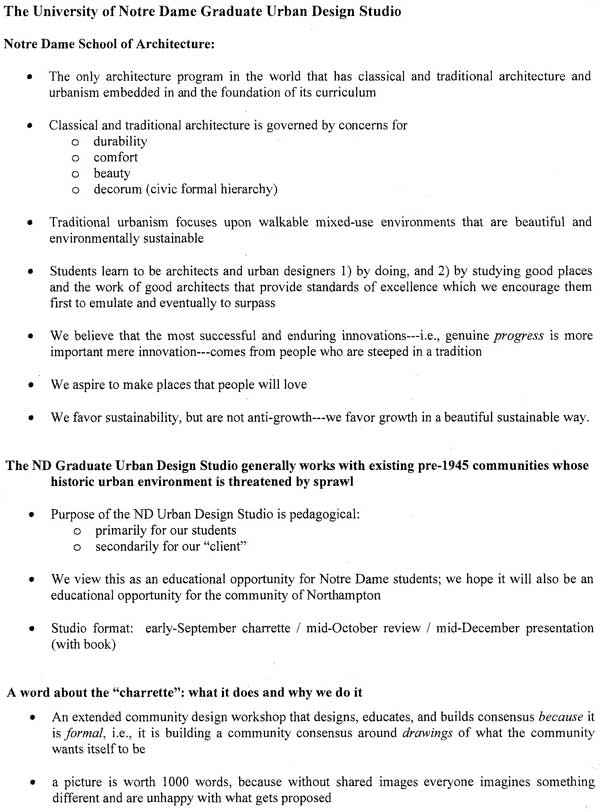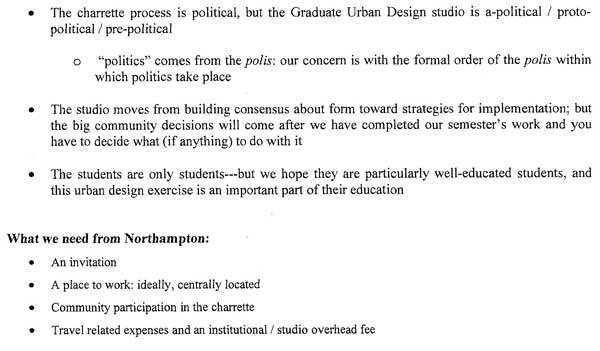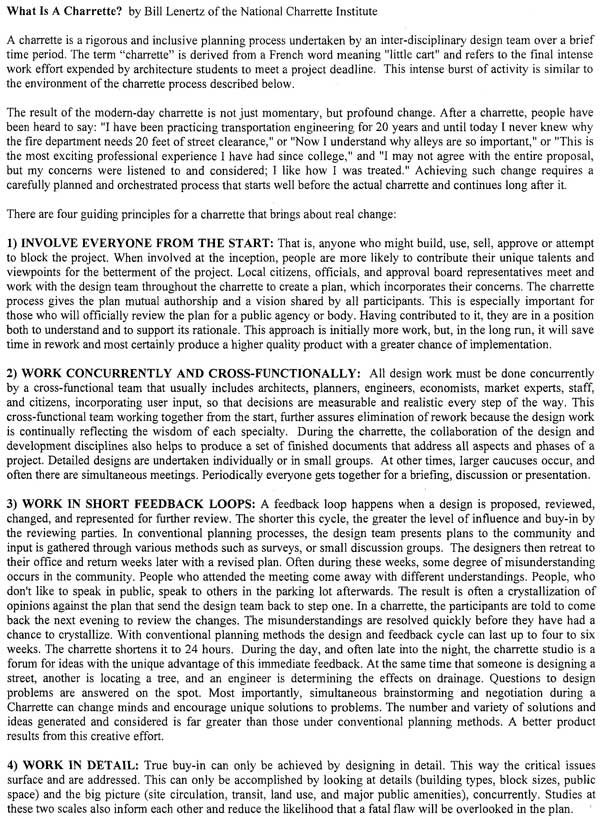To a crowded June 2 audience in City Council Chambers, Professor Philip Bess from the Notre Dame School of Architecture offered an urban design studio to Northampton. Effectively, the studio would help visualize some of the concepts in the Sustainable Northampton Plan, such as compact, mixed-use development. The components of the studio would be an intense week-long public charrette in early September, a review in mid-October and a presentation in mid-December. Notre Dame performed a similar exercise for Cooperstown, NY in 2007 (see their report). We will make videos of Professor Bess’s presentation available within a few days.

Today’s Gazette has an article about the presentation:
Notre Dame pitches urban-design workshop
What would Northampton’s downtown streetscapes and established neighborhoods look like if infused with classical and traditional architecture?
It’s a question the city has an opportunity to explore with graduate students from the University of Notre Dame’s School of Architecture next fall, an effort that could cost anywhere from $15,000 to $20,000…
The program works this way: A half dozen advanced graduate students at the University Notre Dame would arrive in September and hold a week-long charrette, or community design workshop, in which city residents could critique and build consensus around actual student drawings of potential development, or infill, in areas of Northampton…
As Bess put it in his presentation Tuesday, “A picture is worth 1,000 words, because without shared images everyone imagines something different and (is) unhappy with what gets proposed.”
…In mid-October, a group of representatives would travel to Indiana for a review of the students’ drawings, after which time those students return to the city in December to give a final presentation of their work…
“We’ll ask people to pledge [to defray the studio’s cost] and see where it goes,” Feiden said, adding later, “The money should be coming from different places.”
Professor Bess distributed this handout (PDF). We have reproduced the first three pages below, outlining the plan for the studio and describing the benefits of charrettes.
Also in the handout is an article entitled, “Why We Teach Classical and Traditional Architecture and Urbanism”, promoting the features of the Notre Dame design curriculum. They are fans of handsome, durable buildings, which sounds good. They are also fans of New Urbanism, and here we had concerns.
As we’ve written before, sprawl happens because we have electricity, phones, cars, a growing population and widespread wealth (PDF). In particular, we have discussed the many concrete benefits of owning a vehicle. When people have a chance to escape crowded environments that lack greenspace, many will do so, especially if they have young children. Living miles away from a city center used to be isolating. Modern technology means that’s no longer the case.
There are certainly aspects of sprawl that merit criticism, but planners and scholars need to understand why so many people like detached homes, private yards and private cars. It’s not just that they’ve been bamboozled by advertising or victimized by conspiratorial car companies. Too often New Urbanists will insist that dense development and mass transit are the only hope for a resource-constrained future, when other solutions, such as more efficient cars and smaller (yet still detached) homes may prove to be more popular, and thus more workable. Popular solutions are less likely to require large government subsidies, cause voter dissatisfaction, or spur leapfrog sprawl. And, too, some of the New Urbanists’ assumptions about the energy-efficiency of multi-unit dwellings are questionable.
With that said, it would be nice to add more visualizations to the debate over Sustainable Northampton, and perhaps head off future condo monotony and large inapt buildings downtown.



See also:
Grasping the Sustainable Northampton Vision: We Need Pictures
The
object of the charrette [public design workshop] is not, however, to
produce verbiage but to produce results on paper in the form of
drawings and plans. This highlights an essential difference between
zoning codes and traditional town planning based on civic art. Zoning
codes are invariably twenty-seven-inch-high stacks of numbers and
legalistic language that few people other than technical specialists
understand. Because this is so, local zoning- and planning-board
members frequently don’t understand their own zoning laws. Zoning has
great advantages for specialists, namely lawyers and traffic engineers,
in that they profit financially by being the arbiters of the
regulations, or benefit professionally by being able to impose their
special technical needs (say, for cars) over the needs of citizens —
without the public’s being involved in their decisions.
Traditional
town planning produces pictorial codes that any normal citizen can
comprehend. This is democratic and ethical as well as practical. It
elevates the quality of the public discussion about development. People
can see what they’re talking about. Such codes show a desired outcome
at the same time that they depict formal specifications. They’re much
more useful than the reams of balderdash found in zoning codes.
What Jane Jacobs Really Saw (Wall Street Journal opinion column, 5/2/06)
Modern planners have contorted Jacobs’s beliefs in hopes of imposing their static, end-state vision of a city. They use a set of highly prescriptive policy tools–like urban growth boundaries, smart growth, and high-density development built around light-rail transit systems–to design the city they envision. They try to “create” livable cities from the ground up and micromanage urban form through regulation. We’ve seen these tools at work in Portland, Ore., for more than three decades. But the results have been dismal and dramatic. The city’s “smart growth” policies effectively created a land shortage, constricting the housing supply and artificially inflating prices.
People Cannot Live on Boutiques Alone: The Myth of Northwest 23rd
Portland’s Northwest 23rd Avenue is lined with classy shops and
restaurants. When residents of the Portland area ask planners for an
example of their vision of a high-density, mixed-use area, they are
often told to look at Northwest 23rd, where residents have supposedly
learned “to walk and ride transit rather than drive.”
As shown on the Thoreau Institute’s Oak Grove tour,
however, the real Northwest 23rd is jammed with cars throughout the
day. This is because local residents are not numerous enough to support
the shops on the street, so those shops have worked hard to attract
people from throughout the area. Nearly all of those people drive to
get there.
… the president of Neighbors West Northwest, the local neighborhood association, told the Oregonian
that the traffic and parking problems that accompany the area’s high
density have made “the livability worse than it was” before the area
became trendy.
…if the goal is to create streets of shops that primarily serve the
local pedestrian neighborhood, then Northwest 23rd is not the model. In
fact, outside of New York City and possibly a few other pre-auto cities
such as Boston and San Francisco, there is no model for such a street
anywhere in the U.S. It is simply not possible for a street of shops to
provide the same services, goods, and value provided by giant Safeway
or Kroger supermarkets, Office Depots, Wal-Marts, and other growing
categories of big-box or warehouse stores…
Smart Growth and Crime
[Jane] Jacobs [who promoted the advantages of mixed-use neighborhoods
in big cities] never claimed her inner-city urban villages suffered
less crime than the suburbs–or, indeed, that any part of her analysis
applied to the suburbs. “I hope no reader will try to transfer my
observations into guides as to what goes on in towns, or little cities,
or in suburbs which still are suburban,” she wrote. “We are in enough
trouble already from trying to understand big cities in terms of the
behavior, and imagined behavior, of towns. To try to understand towns
in terms of big cities will only compound confusion.”
…There clearly is a market for New Urban-style communities, mainly
among young singles, double-income-no-children couples, and people who
appreciate bohemian lifestyles. Families with children, empty nesters,
and people who prefer a quieter neighborhood are not so interested.
For
many New Urbanists, it isn’t enough to build to the market. The
Congress for the New Urbanism, founded in 1993, declares on its Web
site that “all development should be in the form of compact, walkable
neighborhoods.”
…[Newman’s] 1972 book Defensible Space…showed that the safest neighborhoods maximized private space and minimized common zones…
“The larger the number of people who share a communal space,” [Newman]
found, “the more difficult it is for people to identify it as being in
any way theirs or to feel they have a right to control or determine the
activity taking place within it.”
…”I am not very impressed with the work of the New Urbanists,” Newman
wrote shortly before he passed away in April 2004. “It is nostalgia–a
throwback to the past, with little thought about what made those
environments work then (long-term occupancy by an identical economic
class and ethnic group), and unworkable today. The residential
environments they are creating are very vulnerable to criminal
behavior, unless, of course, these environments are exclusively
occupied by high-income groups.”
Planning Board Adopts Sustainable Northampton Plan
We are encouraged by language like “ensure that new development does
not degrade the quality of existing neighborhoods and mitigates
traffic” and “encouraging designs compatible with historic
neighborhoods”. We are concerned, however, about the reference to
densities of 50 years ago. Much has changed since then. In particular,
women have far more jobs outside the home, meaning more cars are on the
road. By the same token, more families have become too busy to dedicate
an adult to shopping in small amounts on a daily basis. If you’re
buying 50 pounds of groceries and supplies at a time, you’re probably
going to prefer to do that by car rather than walk or use the bus.
Factors like these mean that a neighborhood that had comfortable
density in 1957 might be perceived as congested with cars today.
“Sprawl and Congestion—is Light Rail and Transit-Oriented Development
the Answer?”
Locales like Portland are tempted to embark on boondoggle rail
projects in order to avail themselves of federal government subsidies:
“It’s predictable that public bureaucrats, the construction industry
and unions, certain professional service providers, and even business
associations would promote such projects, each reaching for a chance to
cash in on some piece of the action.”
NY Times Magazine: “The Autonomist Manifesto (Or, How I Learned to Stop Worrying and Love the Road)”
Even with $5-per-gallon gasoline, the number of cars per capita in
Europe has been growing faster than in America in recent decades, while
the percentage of commuters using mass transit has been falling. As the
suburbs expand, Europe’s cities have been losing people, too. Paris is
a great place to visit, but in the past half-century it has lost
one-quarter of its population…
Intellectuals’ distaste for the car and suburbia, and their fondness
for rail travel and cities, are an odd inverse of the old aristocratic
attitudes. The suburbs were quite fashionable when only the upper
classes could afford to live there…
Some…especially the
young and the childless, are moving back to cities, and once again
there are private developers ready to meet their desires, which now run
toward lofts and historic town houses with modern kitchens. But for
most middle-class families, the ideal of city life conflicts with the
reality of their own lives. Even if they’re willing to do without a
yard, how can they afford to live in a decent neighborhood within easy
commute of their jobs? How will they go shopping on a rainy day with a
child in tow?
Smart Growth Winners (Rich People) and Losers (Other People)
Berkeley, California: Cautions on Infill
In 1990, 60 percent of New Yorkers said they would live somewhere else
if they could, and in 2000, 70 percent of urbanites in Britain felt the
same way. Many suburbanites commute hours every day just to have “a
home, a bit of private space, and fresh air.” But unfortunately,
running off to suburbia or to the wilderness to find contentment is
becoming environmentally and economically unviable.
We must draw
people back into relatively compact urban areas. Showcase cities that
have managed to attract would-be suburbanites into increased core
densities have done so through neighborhood revitalization and by
giving priority to quality of life, not density. This is the opposite
of what Berkeley is doing…
Renters and other high-density
residents are expected to do without adequate living space, greenspace,
quiet, and cars; and without cars, they lack the freedom, pleasure, and
mobility taken for granted by average Americans. This is ethically
unacceptable…